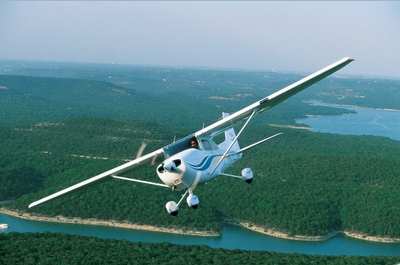Injured Flyers Also Sue Cessna For Seat Catch Failure
A man and his daughter, injured in a June 2005 plane crash on
Martha's Vineyard are suing their pilot, and planemaker Cessna --
among others -- for damages, stemming from the accident they say
was caused by lack of communication with a hearing-impaired
aviator.

According to The St. Louis Post-Dispatch, a lawsuit filed last
week in US District Court states Jeffrey Willoughby, 42, and his
13-year-old daughter were passengers in a Cessna 172 flown by Alec
Naiman on June 23, 2005. Naiman and Willoughby are both members of
the Deaf Pilots Association.
 The
three were flying to Katama Airpark, a non-towered airport near
Edgartown, MA. The field had been notified numerous times of the
arrival of the deaf pilots, according to the lawsuit, so that
precautions could be taken by other pilots in the area.
The
three were flying to Katama Airpark, a non-towered airport near
Edgartown, MA. The field had been notified numerous times of the
arrival of the deaf pilots, according to the lawsuit, so that
precautions could be taken by other pilots in the area.
When their plane was on final to land at Katama,
however, a WACO biplane was already on the runway. Naiman pulled up
to avoid a collision... at which point the pilot's seat catch
broke, causing Naiman's seat to slide back. With Naiman's hand
still on the yoke, the plane's nose pitched into a steep climb
attitude, which led to an aerodynamic stall.
The aircraft fell about 100 feet onto the ground, and all three
onboard were seriously injured. Jeffrey Willoughby suffered a
concussion, back and leg injuries, which according to the lawsuit
prevents him from working as a field engineer.
There are differing accounts as to whether the airport manager
and pilots at Katama knew when the deaf pilots were planning to fly
in. According to the National Transportation Safety Board's final
report on the accident, the manager of Katama Airfield told
investigators he was contacted only once about the deaf pilots
flying in, and that the interpreter failed to provide him with an
exact date and time the aviators planned to land at Katama.
The DPA secretary offered a differing statement. "On June 3 and
June 11, the Secretary's sister spoke to the airport manager via
telephone to coordinate the fly-in, and agreed to call again the
night before arrival to provide the exact date and estimated time
of arrival," the report states. "Via an interpreter, the Secretary
called Katama on the evening of June 22, and the afternoon of June
23, to provide updates on the group's arrival. The Secretary could
not recall who received the most recent telephone calls, but his
wireless telephone invoice revealed a 3-minute call to Katama on
June 22, and a 1-minute call to Katama on June 23."
The pilot of the WACO told investigators he attempted several
times to notify traffic on the common traffic advisory frequency of
his plans to take off from runway 3... and twice had to pull off
the runway when he saw other planes approaching the airport. "The
pilot of the Waco attempted to contact both pilots that landed, but
received no response," the Probable Cause report states. "The pilot
again announced his intentions of the CTAF, received no response,
and resumed the back-taxi on runway 3. As the pilot approached the
runway threshold, he observed another airplane turning on final
approach for runway 3. The pilot taxied the Waco off the runway,
and the landing airplane began a go-around. The pilot of the Waco
further stated, "I saw him pull the nose way up and observed the
left wing drop, and the airplane hit the ground."

The NTSB ruled the Probable Cause of the accident was "the
pilot's failure to maintain airspeed during a go-around, which
resulted in an inadvertent stall and subsequent impact with
terrain. A factor was the pilot's hearing impairment," which
prevented him from transmitting or receiving radio calls, or
hearing the plane's stall warning horn.
Jeffrey Willoughby's lawsuit seeks over $1 million in damages
from Naiman, Edgartown, the biplane's owner and pilot, Katama
Airpark and the field manager, and Cessna.
 SpaceX to Launch Inversion RAY Reentry Vehicle in Fall
SpaceX to Launch Inversion RAY Reentry Vehicle in Fall Aero-News: Quote of the Day (04.23.24)
Aero-News: Quote of the Day (04.23.24) Aero-News: Quote of the Day (04.20.24)
Aero-News: Quote of the Day (04.20.24) ANN's Daily Aero-Linx (04.20.24)
ANN's Daily Aero-Linx (04.20.24) Aero-News: Quote of the Day (04.21.24)
Aero-News: Quote of the Day (04.21.24)





